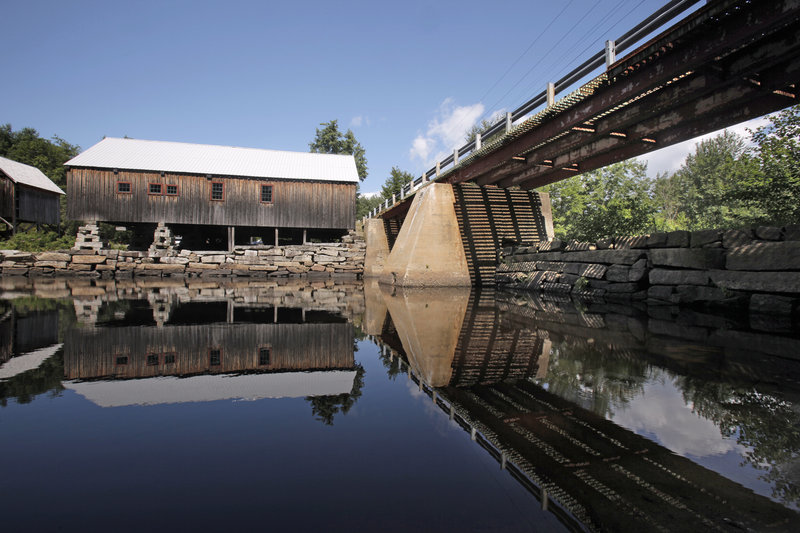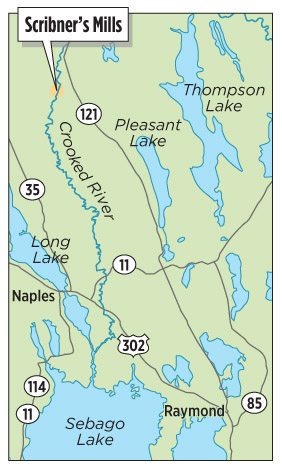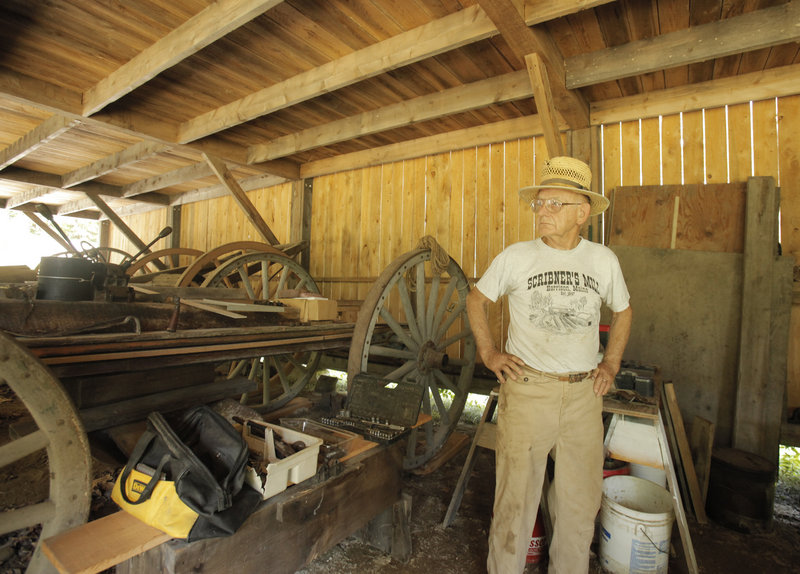HARRISON – Down a long dirt road and around a bend in what seems like the middle of nowhere, Scribner’s Mill stands frozen in the 19th century.
The complex of wooden buildings was once the site of a bustling sawmill that used the power of the Crooked River to turn logs into lumber, clapboards and shingles. Although the mill buildings have been restored to their glory days, the antique machinery in them sits largely silent.
Whether a dam will be rebuilt, allowing the machinery to come back to life on water power, will soon be decided, ending a years-long battle between the group that restored the mill and environmental and wildlife advocates.
Scribner’s Mill Preservation Inc. was denied in its first attempt to get permission to rebuild the dam in 2008, but last week the Department of Environmental Protection began reviewing a new plan by the nonprofit group.
Letters went out to about 20 state environmental and wildlife officials and private organizations seeking comments on the proposal. They have until Sept. 30 to reply.
At issue is whether the dam will negatively affect the ecologically and economically important landlocked salmon that spawn in the river.
“The question is whether the fish and the sawmill can coexist,” said Dana Murch, a DEP hydropower specialist and manager of the review process.
Advocates say rebuilding the dam will allow the sawmill to turn out historically authentic wood products and allow visitors a peek into 19th-century New England life. They say reusing the original water power is less polluting than running the machinery on fossil fuels.
“To me, it has a positive impact on the river,” said Rick Jackson, president of the Scribner’s Mill restoration group.
‘IT NEEDS TO BE PRESERVED’
The mill was built by the Barrows family in 1847 and sold several years later to Elijah Scribner. The mill ceased operations after his grandson Jesse Scribner retired at the age of 92 in 1962.
Ten years later, the dam was breached. The complex and the adjacent Scribner homestead were purchased a few years later by the preservation group, whose principals are John and Marilyn Hatch.
The complex has been turned into a living history museum visited by hundreds of people every summer when it opens between 1 and 4 p.m. on the first and third Saturdays of the month.
“This is a wonderful site, and it needs to be preserved,” Marilyn Hatch said.
The mill was removed from the National Register of Historic Places in 1976, after part of the mill house collapsed from an ice jam. The damaged portion has since been rebuilt.
Supporters say the mill contributes to the region’s economy and is more important as a historic site than a fishery. Elaine Smith, president of the Harrison Historical Society, said the mill complements the Harrison Historical Society Museum, which houses a collection of farm equipment.
“I am afraid I am not sympathetic to the few fish,” Smith said.
This is the second time the preservation group has sought permission to rebuild the dam on the 50-mile river, which flows from Songo Pond in Bethel to Sebago Lake, the source of drinking water for about 200,000 customers of the Portland Water District.
The first proposal was filed in 2002. After much revision, it called for a 4-foot dam, a rock ramp fishway and a 10.8-acre impoundment that extended a mile up the river.
DEP rejected the proposal in 2008, citing the threat to the landlocked salmon. The Scribner’s Mill group appealed the decision, twice, but lost both times.
The new proposal is for a much smaller operation: a 3-foot dam and fishway that would impound 2.6 acres of water extending three-tenths of a mile upriver. Marilyn Hatch said the new dam proposal would barely provide enough power to operate the mill.
But many of the environmental groups say the new proposal has not changed their earlier objections. They say any dam would harm the river, one of only seven recognized by the state as a significant inland fishery. They say the sawmill can operate without the river as its power source.
“Damming this river is wrong,” said Nick Bennett, staff scientist at the Natural Resources Council of Maine.
The river is one of only four drainages in Maine serving as the natural home of landlocked salmon, the only species of salmon that spends its entire life cycle in freshwater instead of moving back and forth between fresh- and saltwater. The fish are native only to Maine, but they’ve been used to breed landlocked salmon stocked in lakes and rivers around the world.
William Oleszczuk of the Sebago Chapter of Trout Unlimited said while it is true landlocked salmon managed to coexist with the Scribner’s Mill dam before it was torn down, the fish are facing more challenges than 50 years ago, such as increased competition from large- and smallmouth bass and pike that people have illegally introduced into Sebago Lake.
“They are definitely more threatened,” Oleszczuk said.
Bennett said a dam would also affect the water quality in Sebago Lake.
The impoundment of water behind the dam would allow material to accumulate there and rot before flowing downriver. He said creating a lake-like environment would cause phosphorus to leach into the water, triggering algae blooms downstream.
“You also raise the temperature of the water, which holds less oxygen and won’t support sensitive fish like brook trout and landlocked salmon,” Bennett said.
If the preservationists are unsuccessful in their latest bid, they will not be allowed another chance.
After they filed their application for a new permit last fall, the Legislature reclassified the Scribner’s Mill section of the river, upgrading it to the AA rating shared by the rest of its length. The new classification requires the entire river to be free flowing, and natural, without any man-made impediments.
Murch said after Sept. 30, the permit applicants will be given 60 to 90 days to review and respond to the comments before the DEP makes a ruling.
Staff Writer Beth Quimby can be contacted at 791-6363 or at:
bquimby@pressherald.com
Send questions/comments to the editors.






Success. Please wait for the page to reload. If the page does not reload within 5 seconds, please refresh the page.
Enter your email and password to access comments.
Hi, to comment on stories you must . This profile is in addition to your subscription and website login.
Already have a commenting profile? .
Invalid username/password.
Please check your email to confirm and complete your registration.
Only subscribers are eligible to post comments. Please subscribe or login first for digital access. Here’s why.
Use the form below to reset your password. When you've submitted your account email, we will send an email with a reset code.